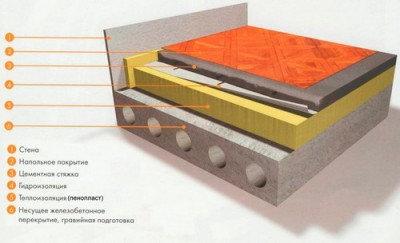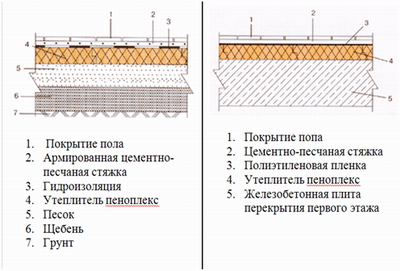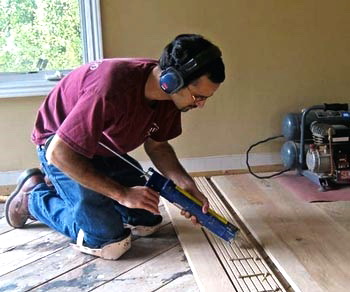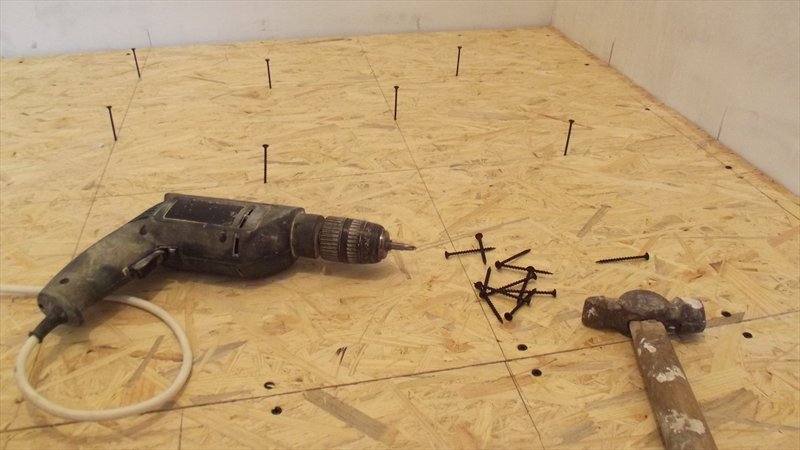Ground floor insulation: how to insulate wooden and concrete substrates
How to more efficiently carry out the insulation of the floor of the first floor of a country house, located above a cold underground or basement, worries every owner. If a solution to this issue is approached negligently and does not perform a number of mandatory work on thermal insulation of the floor, then you can forget about comfortable living. Cold floors will spoil the whole picture, bringing a lot of inconvenience to family members. Of course, there are technologies that warm the floors of the first floor in already constructed buildings. However, it is better to take care of this at the stage of building a house. It is much more profitable both in terms of time and money. You can use different methods of insulation, without looking at the height of the ceilings and the need for a large amount of "wet" work. In this article we will consider the main options for conducting thermal insulation work on the insulation of a wooden or concrete floor on the first floor.
Ground floor insulation of a wooden house
In wooden houses, thermal insulation works are carried out according to the technology of the device of the double floor. At the same time, antiseptic treated flooring is provided. Next, the selected heat insulator is laid in the space between the lags and covered with a layer of vapor barrier material. Then proceed with the installation of the final floor covering. As you can see, the methods of warming the floor of the first floor in wooden houses differ only in the choice of material for laying one or more layers of thermal insulation. Otherwise, the construction of the “pie” has remained unchanged for many years now, the construction of residential buildings.
Important! When warming a wooden floor, preference is given to soft and flexible heat-insulating materials having low density and low weight. Mineral wool plates or foam foam can act as such a heater.
So, here is a list of steps for work:
- Dismantle the finish floor.
- On a rough floor lay a layer of roofing material, which acts as a waterproofing. Ruberoid will protect the heat insulator from moisture, which the material can absorb from the wooden base. In a humidified heat insulator, the characteristics of thermal conductivity change, which affects the deterioration of the thermal insulation qualities of the material.
- A layer of sand is poured onto the roofing material, which is leveled with a rake or other improvised tools.
- Next, the sand layer is closed with several layers of dense plastic film. Attach the edges of the film with a construction stapler to the lags. Use adhesive tape to fasten the strips together, even if they were overlapped.
- Next, lay the penoplex - a modern heat-insulating material with excellent heat-insulating qualities, as well as perfectly absorbing sounds. Penoplex is non-combustible, chemically inert, environmentally friendly to humans, and easy to install.
- Then lay the chipboards in two layers, which will serve as a raised floor, while remember to retreat from the walls by 15 mm around the entire perimeter of the room.
- Place the selected flooring on the finished raised floor surface.
Such a floor will definitely be warm. The main thing is to comply with all the requirements of the technology and purchase high-quality building materials.
Insulation of the concrete base in the apartment
The process of warming floors made of concrete in apartments located on the first floors of multi-apartment buildings differs in many respects from thermal insulation works in a country house. In apartments, it is sufficient to use leveling concrete screeds or self-leveling self-leveling floors, on which rolled thermal insulation materials are then laid, on top of which floor coverings are placed. If in a country house the concrete floor is laid on the ground, then the issues of warming are taken into account when mixing the concrete solution, replacing crushed stone with expanded clay or adding sawdust to the cement-sand mixture.

Sawdust concrete floors are poured in two layers, each of which contains a different amount of sawdust. To fill the first layer, a mortar is mixed, consisting of one part of cement, two parts of building sand and six parts of sawdust. The thickness of the first layer should be at least 80 mm. The second thinner layer is poured with a solution in which the amount of sawdust is halved, leaving the ratio of cement to sand the same. After the final hardening of the concrete floor, the flooring is laid. This method of insulation is considered low-cost and environmentally friendly.
Ground floor insulation
In this case, it is necessary to carry out the following operations:
- compact the soil surface;
- make a layer of large crushed stone, the thickness of which should be 10 cm, and carefully compact it;
- then pour a 10-centimeter layer of sand with its subsequent compaction;
- to carry out the laying of foam foam plates - an effective insulation having a closed-cellular structure;
- followed by a layer of waterproofing, which can be made of a thick plastic film laid in two layers, or from a special waterproof membrane;
- then proceed to pouring reinforced cement-sand screed, the minimum thickness of which is 50 mm;
- finish work on the installation of insulated floors by installing the design of the finish floor covering.

Important! This method of warming works even in houses built in areas with extreme operating conditions: close occurrence of groundwater, exposure to low temperatures, increased mechanical stress.
Basement floor insulation without heating
Warming of a floor made of concrete slabs serving as a ceiling separating an unheated basement from the premises of the first floor is carried out according to the following scheme:
- On the surface of the base concrete floor leveled with a screed, foam boards are laid.
- Then a plastic film is laid.
- Then you can go in several ways, choosing one of the options as a layer distributing point loads: a cement-sand screed or gypsum-fiber sheets, the installation of which is carried out in two layers.
- At the end of the work, any of the flooring is laid in accordance with the recommendations given by the manufacturer.
Modern heat-insulating materials manufactured using the latest technologies simplify the process of floor insulation of the first floors of houses and apartments. You can always choose a suitable insulation and method of thermal insulation, forgetting about the problem of a cold floor forever.




1 comment